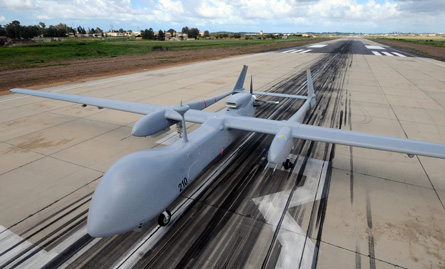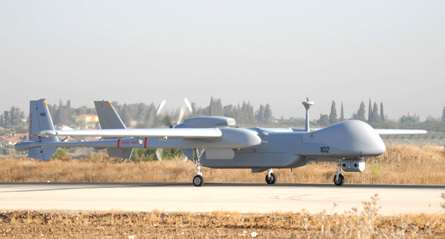Israel has for the first time opened the doors at its newest unmanned air vehicle unit, offering Flight International the chance to see its strategic Heron TP, or "Eitan" system on the frontline.
Designed as a multi-mission platform to answer the requirements of the nation's air force, the Heron TP is the largest UAV manufactured by Israel Aerospace Industries' Malat division.
Powered by a Pratt & Whitney Canada PT-6A 1,200hp (895kW) turboprop engine, the medium-altitude, long-endurance type can fly above 40,000ft (12,200m) and has a 36h endurance.
With a 26m wing span and a maximum take-off weight of 4,650kg (10,200lb), the UAV's twin tail-boom design provides a large internal volume to accommodate multiple payloads, typically weighing a combined 1,000kg.
 |
|---|
© Israeli air force |
For the Israeli air force, the Eitan carries a multi-sensor payload beneath its nose. The service is reluctant to even hint about the specifications of the additional equipment that it could carry, but says the design could eventually replace four or five of its manned surveillance types.
Unlike other Israeli UAV squadrons, the Eitan unit is located at Tel-Nof air base, alongside manned fighters and helicopters. The fact that the types are all required to use the same runways means that air force personnel are learning to coexist.
"The process is under way and is moving ahead very positively," says one of the UAV's operators.
"This is the best proof that UAVs are becoming an integral part of our force," says the officer responsible for preparing Israel's first heavy UAV squadron for full operational capability, identified only as Major "O".
His team is writing everything from scratch, from equipment numbers and operational procedures to maintenance manuals.
Maj O's team has gained vast experience in operating other UAVs with the Israeli air force. But he comments: "This is different. This big UAV is a real aircraft: its dimensions and capabilities are a different story, and we learn as we move forward."
Despite its large size, the Eitan is described as being very easy to operate and fly. "Four clicks on the computer mouse and it starts the engine, taxis, stops on the runway threshold and takes off," Maj O says.
A fully-loaded air vehicle rotates after a take-off run of only 200-300m. "It is very impressive, and it will be reflected in our capabilities," he says.
 |
|---|
© Israel Aerospace Industries |
Maj O singles out the performance of the PT-6A as a particular strong point of the system design. "This engine was adapted for use on UAVs and is over-powered, so we see a potential to carry even heavier payloads as we gain experience."
Another feature that is mentioned in every conversation with squadron personnel is the use of triple redundancy in all the Eitan's crucial systems.
"No more back-to-base mode as a result of each malfunction," says one operator. "This bird can really perform long missions in time and range."
Israel has yet to decide on the eventual size of its Eitan squadron. "The endurance will determine the number of platforms we will eventually operate," says Maj O. "With a 36h endurance no doubt the number will be much smaller than of manned aircraft squadrons."
IAI is already offering the Heron TP to international users, for example under a teaming agreement with Rheinmetall Defence in pursuit of the German air force's long-term "Saateg" MALE UAV requirement.
Source: Flight International



















